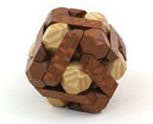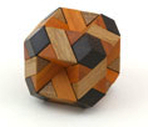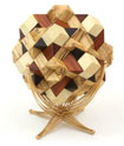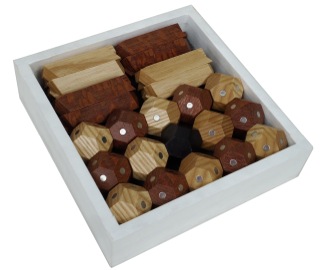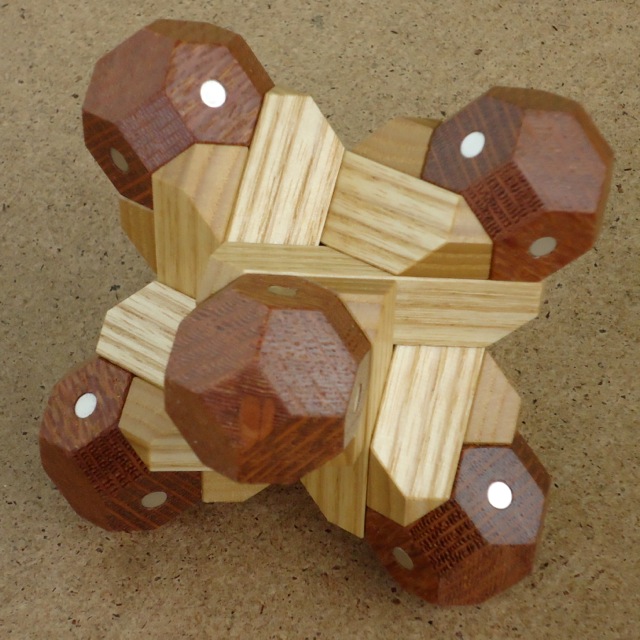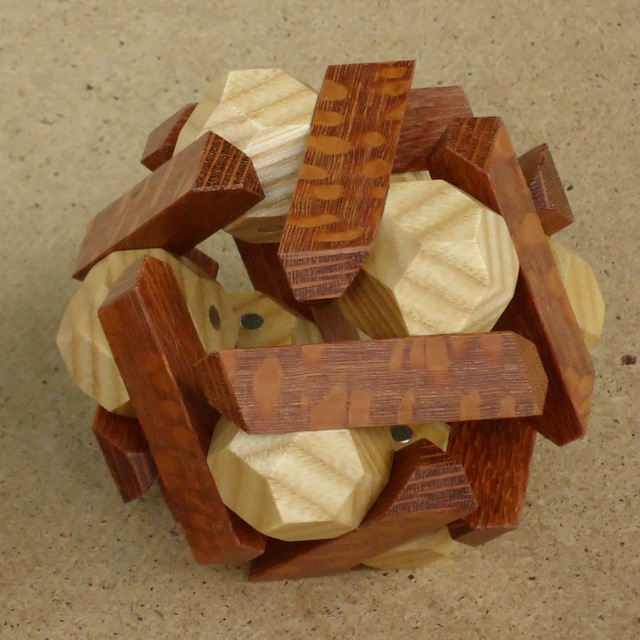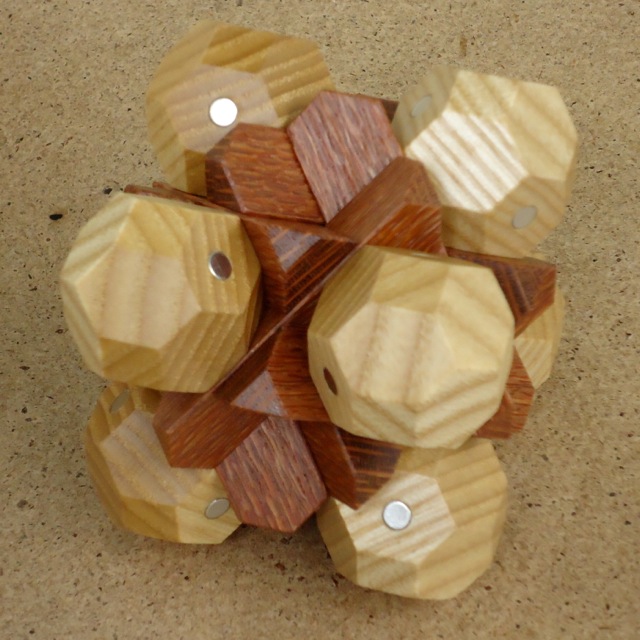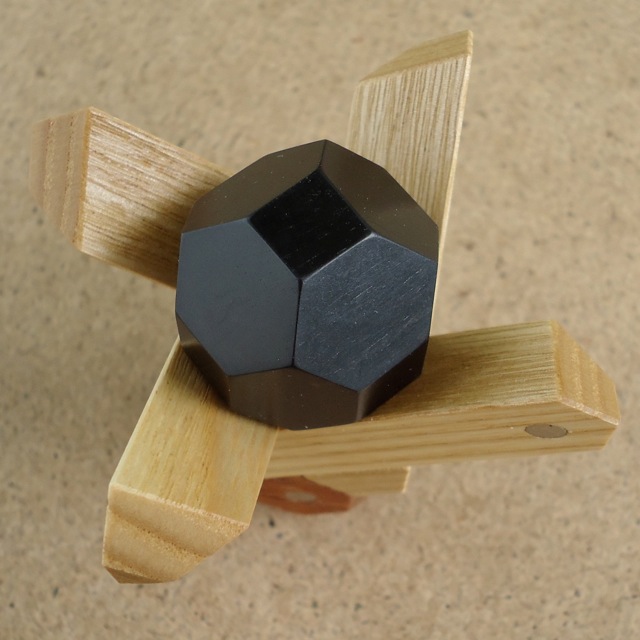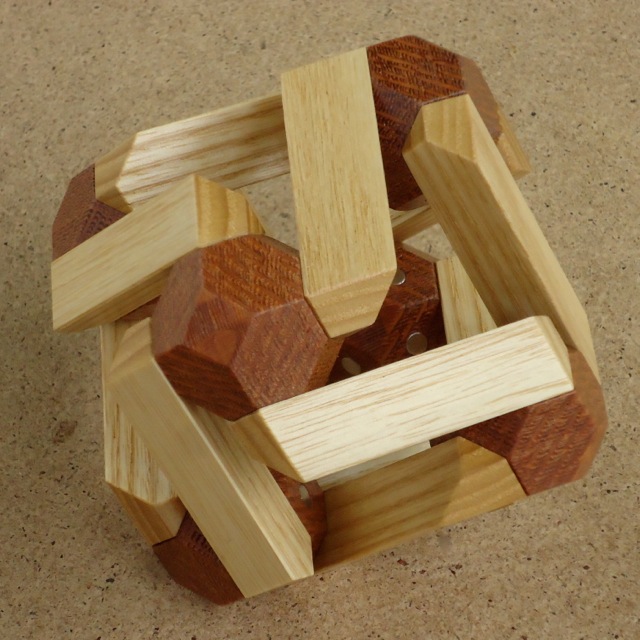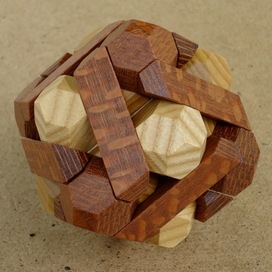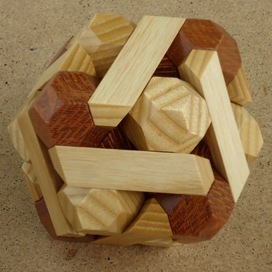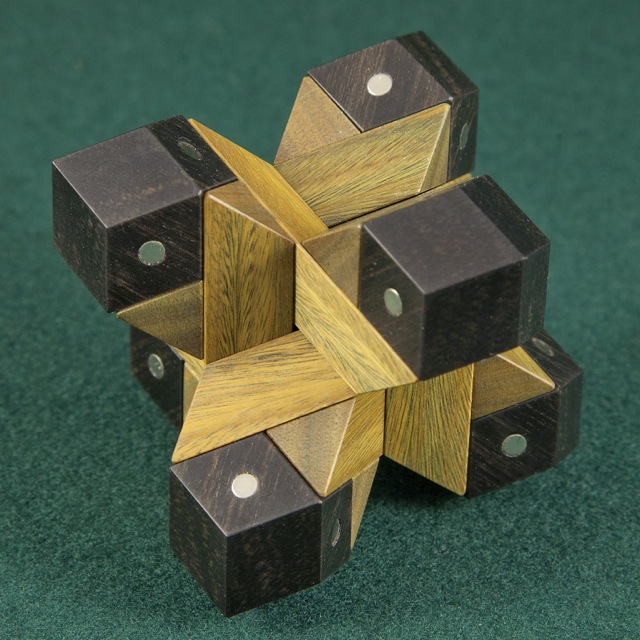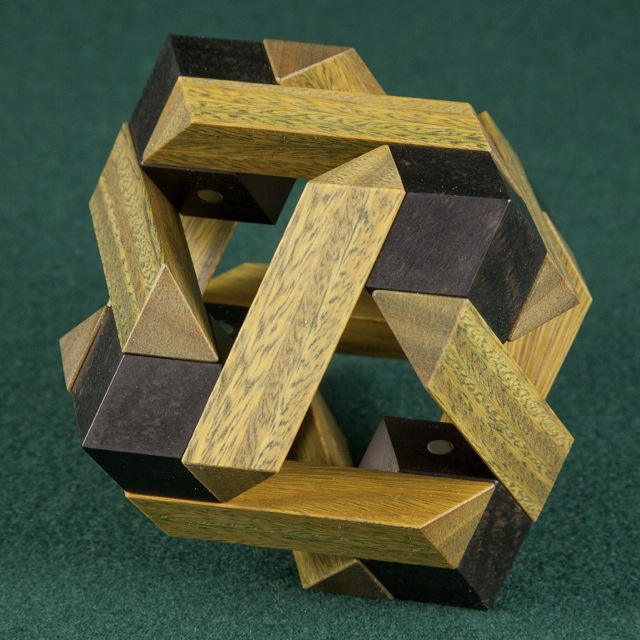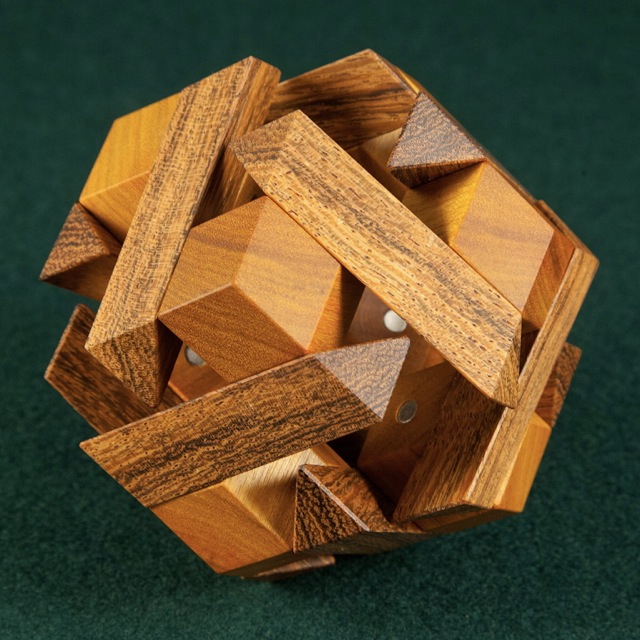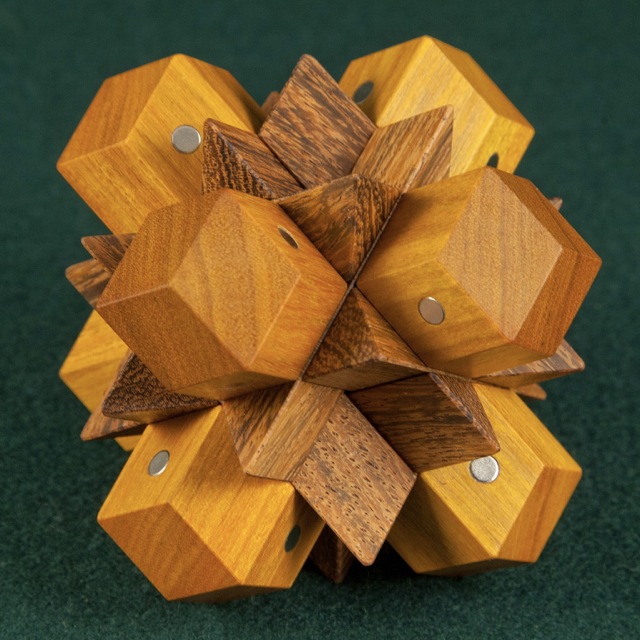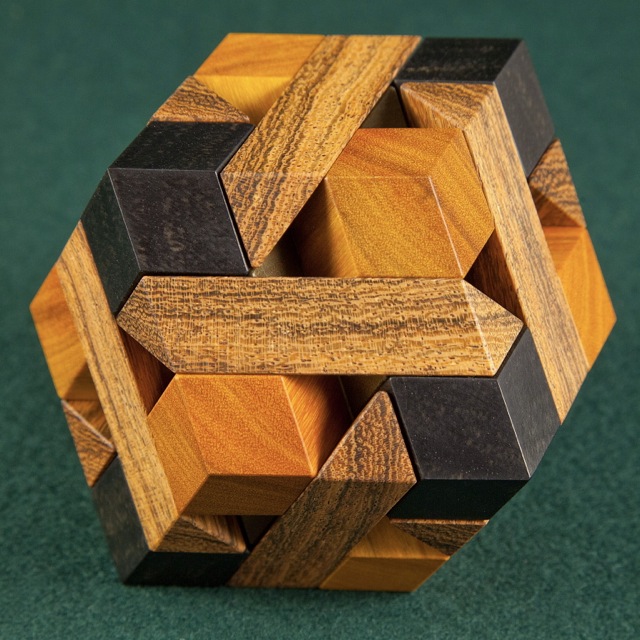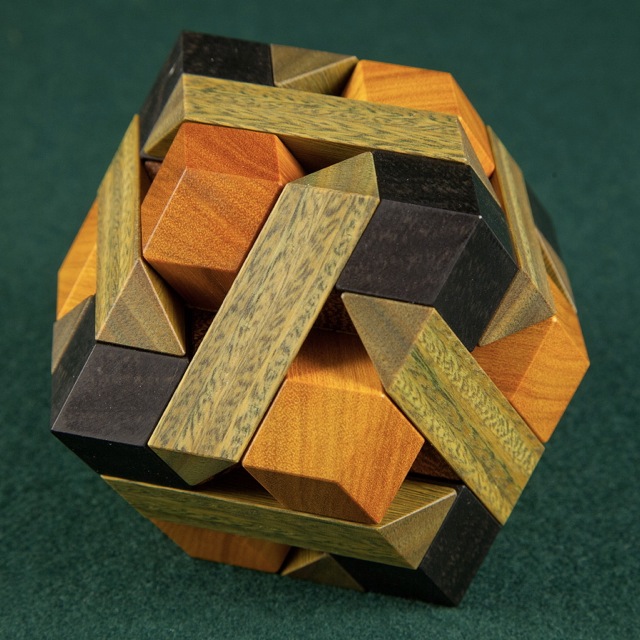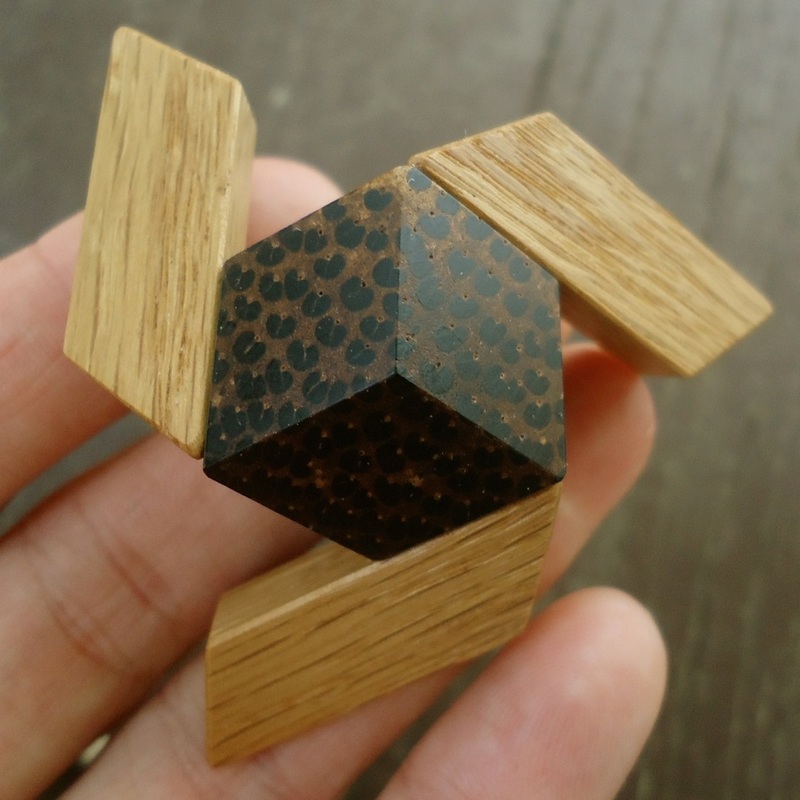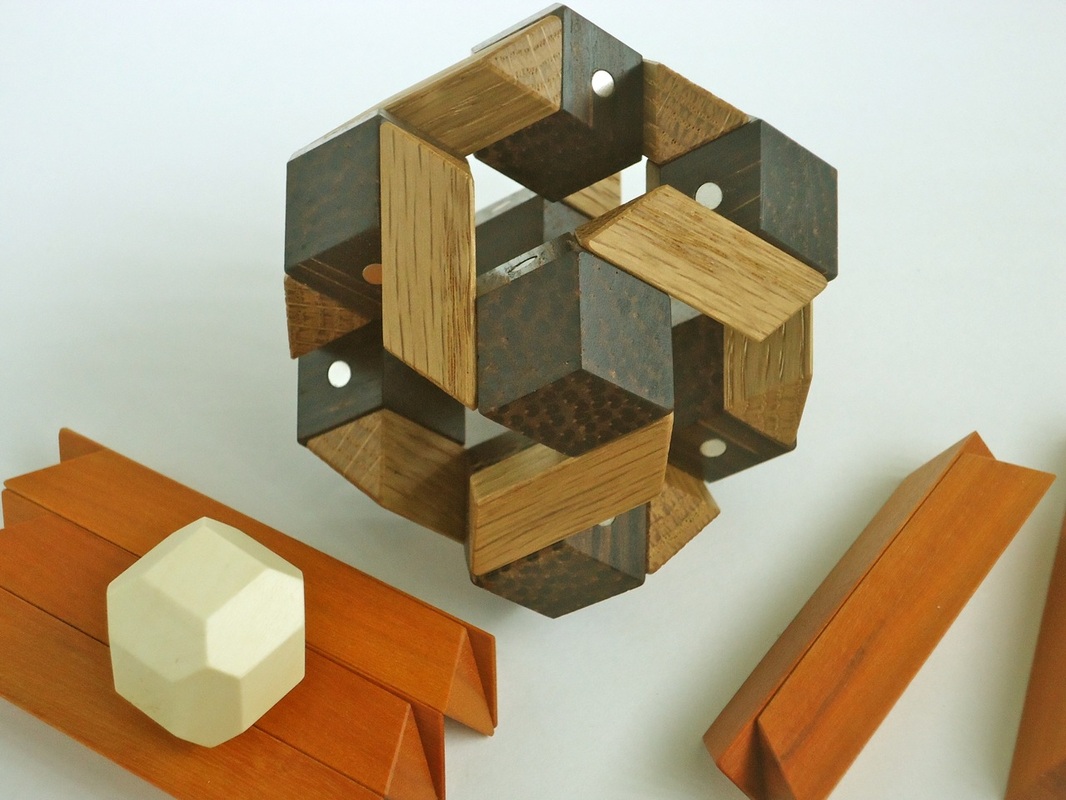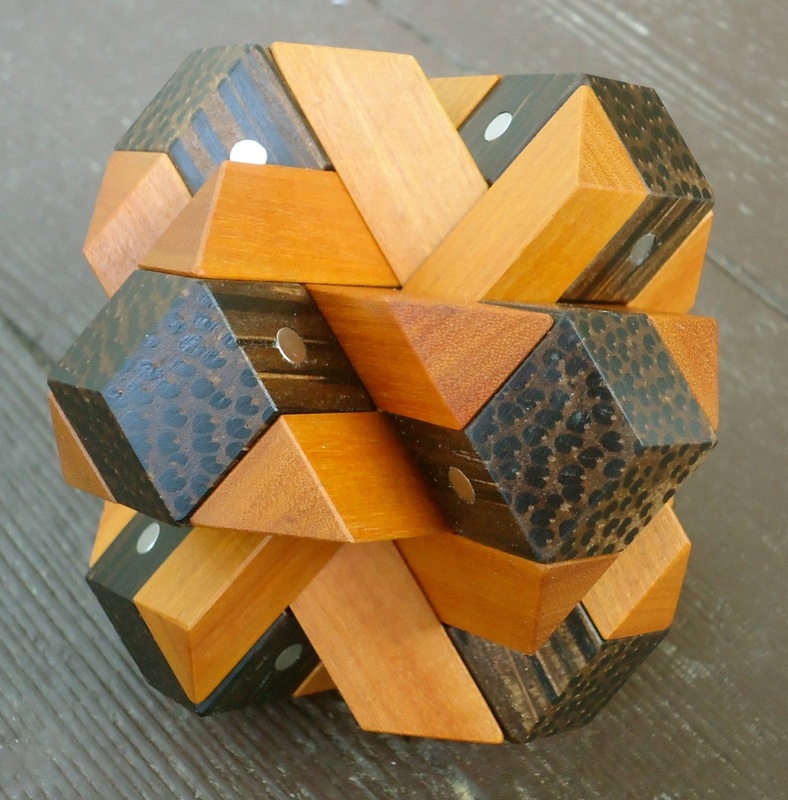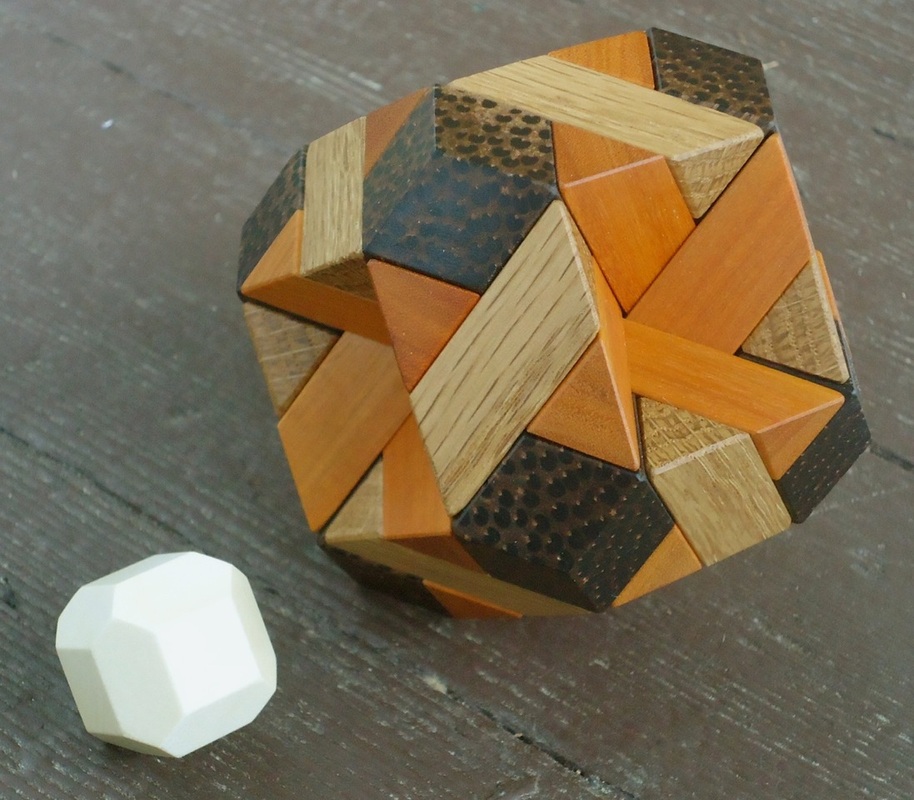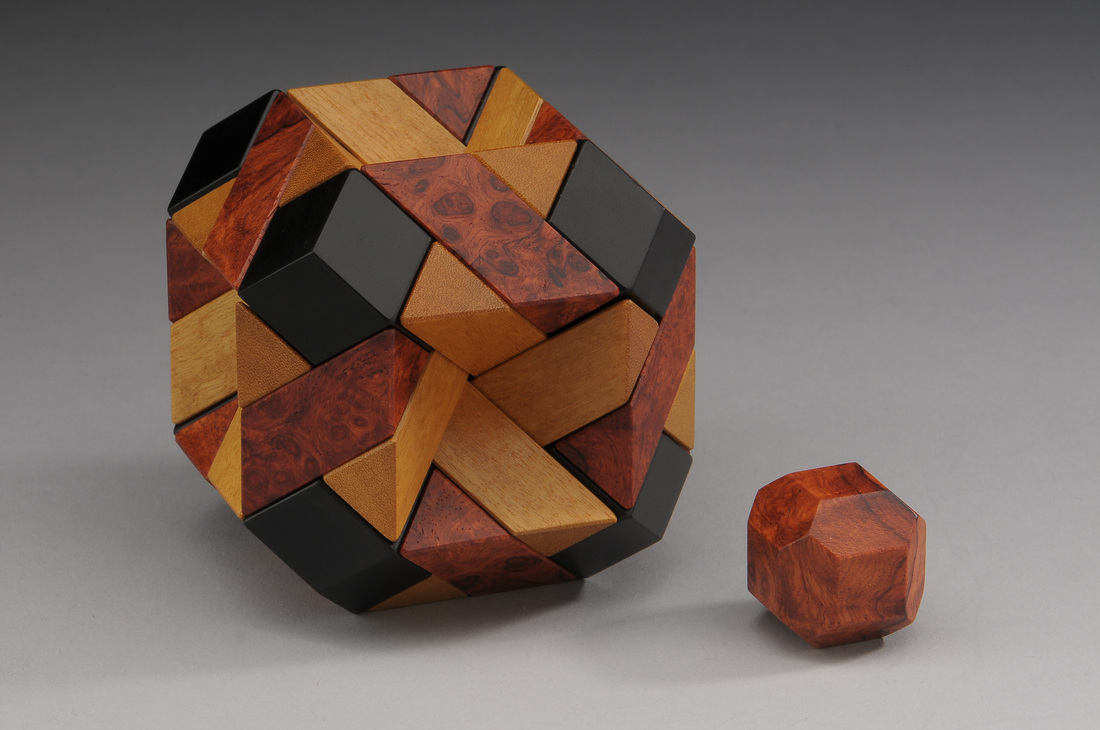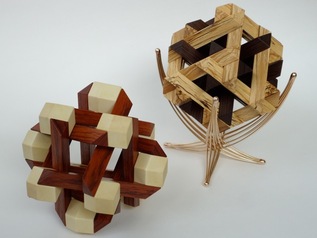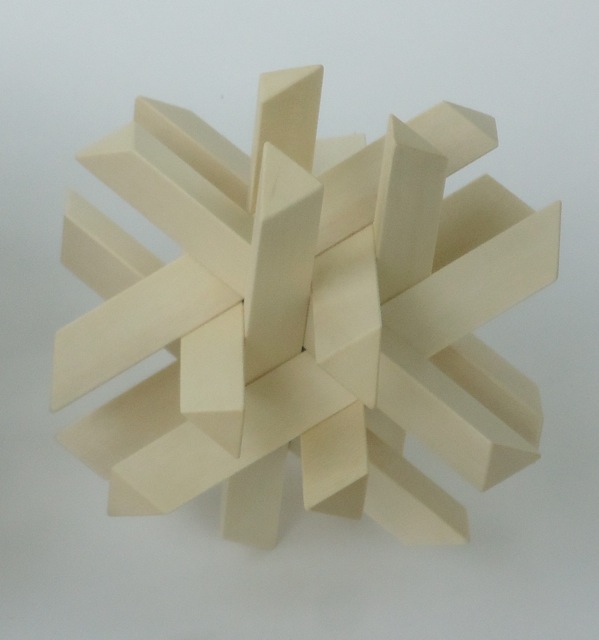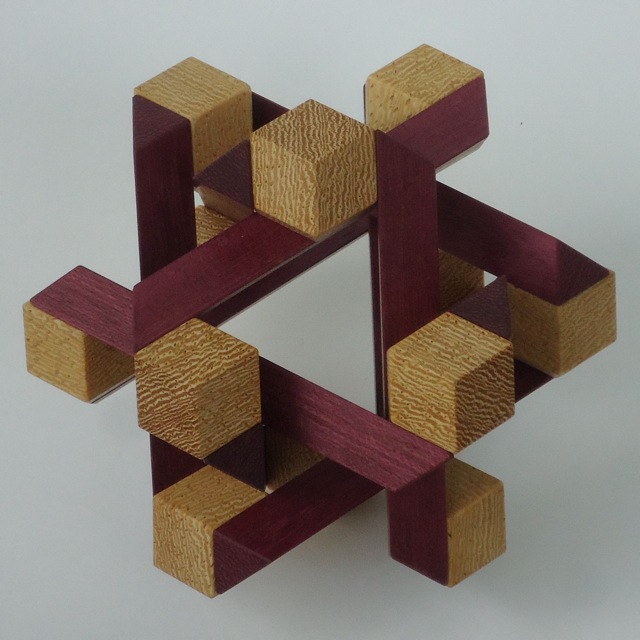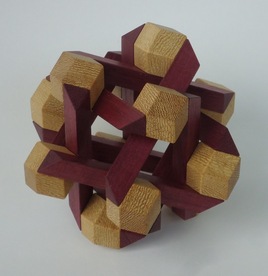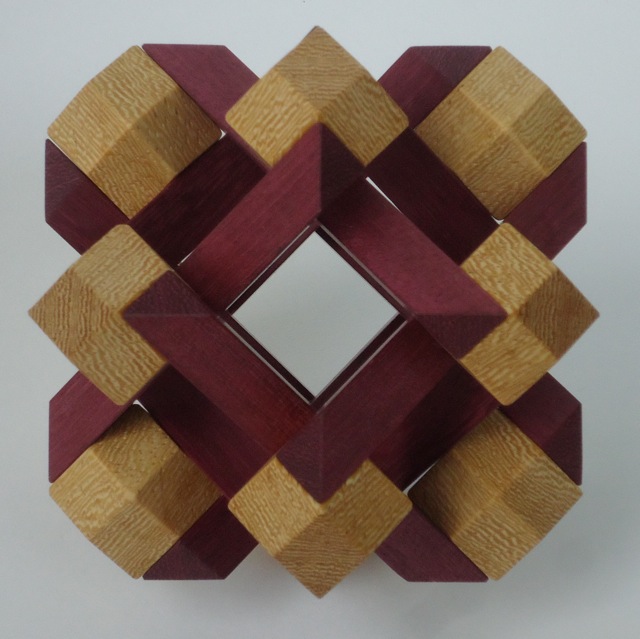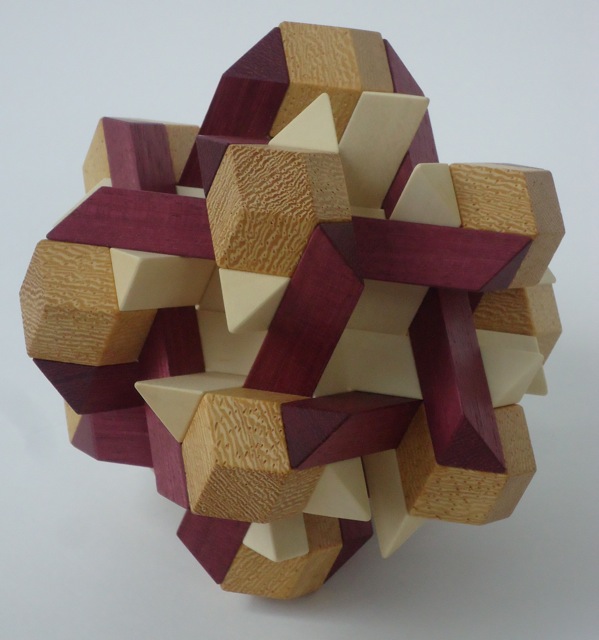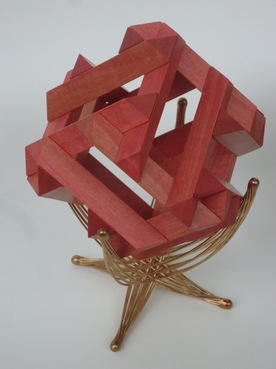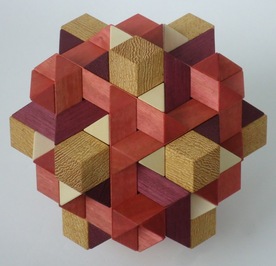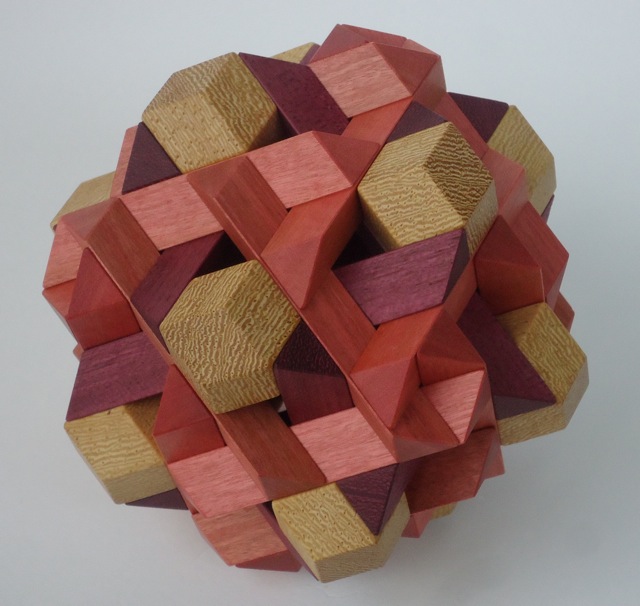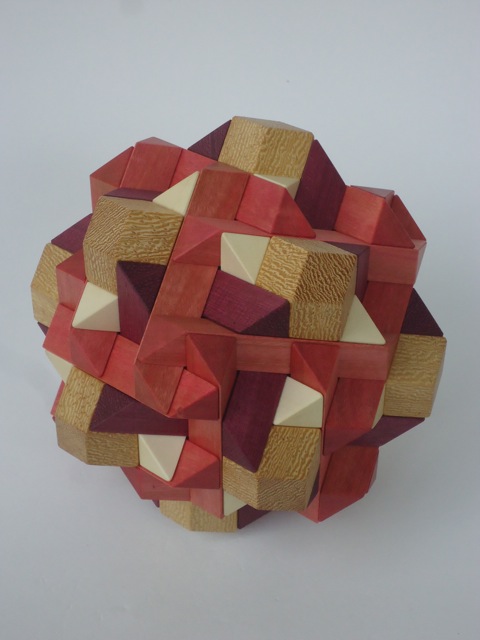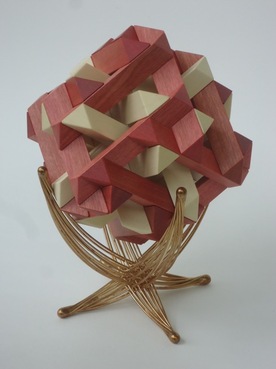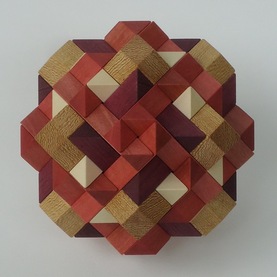Double Duals, Chamfered Cube, and 3-Layer Tetraxis® Array
These three closely related designs were on display at the 32nd annual International Puzzle Party held in Washington DC in 2012.
Double Duals
Double Duals is a set of 24 sticks and 15 blocks. A cube and an octahedron are two shapes that are called duals of each other. Double Duals gets its name from the feature that the pieces can be assembled so that a composition whose blocks are at the corners of an octahedron can fit inside of another composition whose blocks are at the corners of a cube, and vice versa. It's an idea that's easier to show with images than to put into words. The assembly goal is better stated in this poem:
|
Assemble a shape that resembles a jack
and one that has traits of a box. Hide the ebony block inside of the jack, and then put the jack in the box. Separate the two shapes, and invert the box. Spread outward the sticks of the jack. Put both shapes together around the black block so all of the parts tightly pack. |
The light wood is ash, which has very visible growth rings, highlighted here by orienting them to make triangles that accentuate the 3-fold corners of the blocks. The darker wood is lacewood, whose strong rays form squares that accentuate the 4-fold corners. All of the blocks are the same shape as each other, as are all of the sticks, but the magnets are positioned differently.
Here is the same design in some different woods.
Here is the same design in some different woods.
And here are a few photos of a version of Double Duals with the sticks and blocks left pointy.
The woods are ebony (black), verawood (green), chakte viga (orange), and camelthorn (brown), which come from Gabon, Argentina, Mexico, and Namibia.
Chamfered Cube
The set of pieces in the Chamfered Cube magnetic assembly consists of 24 sticks and 9 blocks, one of which is a small chamfered cube. In woodworking, chamfering means cutting the sharp edge off of a piece of wood, usually with a 45º bevel. So a cube that has all 12 of its edges chamfered looks like the white holly block in the images below. The goal with this assembly is to compose a large chamfered cube out of all of the pieces. The holly block can fit snugly in the center of the arrangement.
One way to put these parts together is by starting with just the short sticks and the eight blocks. Three sticks attach to a block (Figure 1) and the pattern is repeated. (Figure 2) When starting with the longer sticks, you use the set of exposed magnets shown in Figure 2 and create an assembly (Figure 3) whose composition of parts is like John's 1965 Tetraxis Star, where the blocks hold together the four sets of three parallel sticks in the same way that the welds hold together the four sets of three wires in each beam of a star. Using both sets of sticks (Figure 4) gets you the large chamfered cube, but with an indented pyramid on each of the six square faces.
3-Layer Tetraxis® Array
This is a set of three different independent compositions that can be displayed either separately or intertwined in pairs or all as one.
Setting on the bronze cradle is Layer 1 together with Layer 3. The composition to the left, Layer 2, is most of the negative space in the assembly to the right.
I've made at least a dozen variations on the design of a 3-Layer Tetraxis Array, some with just sticks, others with both sticks and blocks. All of them are inspired by some glass stars that John was making back in the '80s, which in turn were based on the wood and metal Tetraxis Arrays he was building about 20 years earlier. Here is a nice one from that time period, a large table base version of the stand shown above.
The images below show the design that was exhibited at the IPP Puzzle Design Competition.
I've made at least a dozen variations on the design of a 3-Layer Tetraxis Array, some with just sticks, others with both sticks and blocks. All of them are inspired by some glass stars that John was making back in the '80s, which in turn were based on the wood and metal Tetraxis Arrays he was building about 20 years earlier. Here is a nice one from that time period, a large table base version of the stand shown above.
The images below show the design that was exhibited at the IPP Puzzle Design Competition.
Layer 1 consists of a block surrounded by 12 sticks. This is easy to assemble, with twelve magnets embedded in the block and one magnet in each of the sticks. The trick is that it can go together with either right-handed or left-handed rotation, but it has to have the rotation shown in order for the rest of the layers to be able to surround it.
Layer 2 is made of 12 sticks and 12 blocks. These are three views of the same object:
Layer 2 is made of 12 sticks and 12 blocks. These are three views of the same object:
The sticks shown here are purpleheart and the blocks are lati, a wood from Africa that is sometimes also called white wenge. This design also looks good made from four different woods, each used for 3 sticks and 3 blocks.
Depending on the number of magnets embedded, either 72 or 48, it can be easier or more challenging to put together Layer 2. Layer 1 works well as an assembly guide.
Depending on the number of magnets embedded, either 72 or 48, it can be easier or more challenging to put together Layer 2. Layer 1 works well as an assembly guide.
